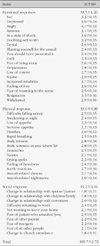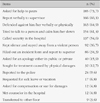Abstract
Purpose
The purpose of this study was to examine workplace violence (verbal, physical, and sexual violence) among nurses in intensive care units (ICU).
Methods
This cross-sectional survey was done from November 8 to 27, 2010, using self-administered questionnaires. The responses of 251 nurses were analyzed.
Results
The results of this study showed that ICU nurses frequently experience workplace violence. Verbal violence was more frequent than physical or sexual violence. The most frequent action taken by respondents after violence was seeking help from colleagues. Violence occurred most often when a patient's mental status was altered or the patient had too much alcohol, and when the patient or family was not satisfied with the hospital services because of delay of test results or treatment. In addition, miscommunication between doctors and nurses or among nurses was a major reason for violent behavior. Nurses regarded public apologies, professional counseling, and communication skill training as effective methods to prevent or deal with violence.
Figures and Tables
References
1. Abbas MA, Fiala LA, Abdel Rahman AG, Fahim AE. Epidemiology of workplace violence against nursing staff in Ismailia Governorate, Egypt. J Egypt Public Health Assoc. 2010; 85(1):29–43.
2. Chapman R, Styles I, Perry L, Combs S. Examining the characteristics of workplace violence in onenon-tertiary hospital. J Clin Nurs. 2010; 19:479–488.

3. Hahn S, Muller M, Needham I, Dassen T, Kok G, Halfens RJ. Factors associated with patient and visitor violence experienced by nurses in general hospitals in Switzerland: A cross-sectional survey. J Clin Nurs. 2010; 19:3535–3546.

4. Hibino Y, Ogino K, Inagaki M. Sexual harassment of female nurses by patients in Japan. J Nurs Scholarsh. 2006; 38:400–405.

5. Hiqqins BL, Maclntosh J. Operating room nurses' perceptions of the effects of physician-perpetrated abuse. Int Nurs Rev. 2010; 57:321–327.

6. Hoff LA, Slatin C. Workplace health and safety: Report of PHASE/MNA focus groups. Mass Nurse. 2006; 77(8):6.
7. Hong MJ. A study on nurses' experiences of violence. Daejeon: Eulji University;2009. Unpublished master's thesis.
8. Iildiz AN, Abadaĭ A, Balkan S, Baĭsal L, Bekhrem N, Sakisi N, et al. Violence as occupational hazard for primary medical care personnel. Med Tr Prom Ekol. 2008; 9:31–34.
9. Jang SJ. Relationship between experience of patients' violent behaviors and burnout of psychiatric nurses. Seoul: Seoul National University;2004. Unpublished master's thesis.
10. Kim MJ. Kinds of workplace violence for hospital nurses and their reaction after being damaged. Seoul: Hanyang University;2008. Unpublished master's thesis.
11. Kim MY, Kim SH, Lim SH. A study of workplace violence by nurses. Nurs Sci. 2005; 17(2):33–44.
12. Kim SY. The recognition of nurses about sexual harrassment. Daegu: Kyungpook National University;2008. Unpublished master's thesis.
13. Kim SY, Ahn HY, Kim HS. Violence experiences of clinical nurses and nurse aids in hospitals. Korean J Occup Health Nurs. 2008; 17(1):76–85.
14. Kim SY, Eom M, Oh HY, Ahn HY. Violence episodes and responses of emergency room nurses. J Korean Acad Fundam Nurs. 2007; 14:446–456.
15. Korea Health & Medical Workers' Union. Survey on emotional labor · verbal abuse · physical violence. 2010. Retrieved November 20, 2010. from http://www.bogun.nodong.org.
16. Kwon HJ, Kim HS, Choe KS, Lee KS, Sung YH. A study on verbal abuse experienced at medical centers. Clin Nurs Res. 2007; 13:113–124.
17. Kwon MH. Violence and its response among nurses in emergency room. Seoul: Hanyang University;2010. Unpublished master's thesis.
19. Lee HH, Chung SE. Nurses's experience of verbal violence in hospital setting. J Korean Acad Nurs Adm. 2007; 13:526–536.
20. Lee JY. An inquiry into the realities of sexual harassment
of nurses, employed in university hospitals . Ewha Womans University;2003. Unpublished master's thesis.
21. Ministry of Government Legislation. Guidelines on sexual harassment at the workplace. 2010. Retrieved November 20, 2010. from http://www.law.go.kr.
22. Pai HC, Lee S. Risk factors for workplace violence in clinical registered nurses in Taiwan. J Clin Nurs. 2011; 20:1405–1412.

23. Park HS, Kang EH. A study on job stress and the coping of ICU nurses. J Korean Acad Nurs. 2007; 37:810–821.

24. Roche M, Diers D, Duffield C, Catling-Paull C. Violence toward nurses, the work environment, and patientoutcomes. J Nurs Scholarsh. 2010; 42(1):13–22.
25. Son M. Violence in the emergency department: A study on the experiences of ED nurses. Seoul: Hanyang University;1997. Unpublished master's thesis.
26. Sung MH. Relationship of the experience of violence to burnout and job satisfaction in emergency department nurses. J Korean Clin Nurs Res. 2008; 14:83–92.
27. Yun JS. A study on job satisfaction and violence experience by ED nurses. Ulsan: Ulsan University;2004. Unpublished master's thesis.




 PDF
PDF ePub
ePub Citation
Citation Print
Print







 XML Download
XML Download